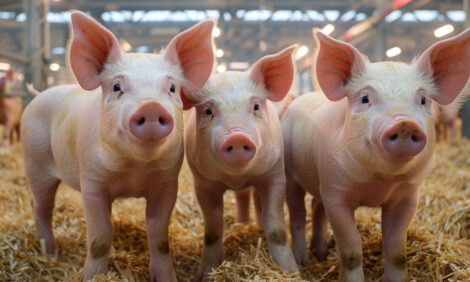



Vaccine trial data versus lineage: What’s the best way to predict PRRS vaccine performance?
An interview with Eva Jablonski, DVM PRRS Specialist Senior Technical Services Veterinarian at Zoetis.
Q: What’s the best way to predict the efficacy of a porcine reproductive and respiratory syndrome (PRRS) vaccine?
EJ: Challenge studies provide the most practical evidence of vaccine performance because they test a vaccine’s effectiveness against circulating PRRS viruses.
Another approach is to try and predict a vaccine’s efficacy based on its lineage or genetic ancestry. The PRRS virus is classified into nine lineages. PRRS vaccines are based on one of those nine strains. When a PRRS vaccine and circulating strain are in the same lineage group, the vaccine is said to be homologous, or similar, to the circulating strain.
Q: How do you judge challenge studies that evaluate PRRS vaccine efficacy?
EJ: Remember, all vaccines for livestock undergo rigorous testing required by USDA for licensure. That provides some level of insurance a vaccine will be effective.
Whether it’s a vaccine for PRRS or any other disease, however, I like to see how it performs in a commercial setting. I want to see that a vaccine prevents or controls disease and improves performance.
Q: What characteristics make a good challenge study?
EJ: Challenge studies can be complicated, but to start, all pigs in the study should be from the same source. Results in vaccinated, challenged pigs should be compared to unvaccinated, challenged pigs.
To prevent bias, people judging outcome such as clinical signs of disease are “blinded”— they won’t know which animals have been vaccinated. There should be a substantial number of pigs — a study with hundreds or thousands of pigs yields more reliable results than one with few animals. I also want studies conducted in a commercial setting to demonstrate a vaccine is safe. Lastly, there should be statistically significant differences between results in vaccinated and unvaccinated groups. That indicates the results are unlikely due to chance.
Q: Besides challenge studies, are there other ways to evaluate PRRS vaccine efficacy?
EJ: There are. One example is serology — blood tests to detect anti-PRRS virus antibodies in vaccinated pigs. More recently, aggregate samples of oral or processing fluids are tested using PCR (polymerase chain reaction) to determine the degree of viremia. Lung lesion scoring is yet another method. These tests are often used during vaccine development and, in general, are better suited for research.
Q: You mentioned PRRS vaccine lineage as a predictor of efficacy. How is lineage determined?
EJ: Lineage is usually determined with molecular techniques and a process called phylogenic analysis. Lengths of genetic material known as open reading frames, or ORFs, are sequenced to find genes that encode proteins.1
The PRRS virus genome has eight ORFs.2 The one known as ORF 5 encodes a major protein targeted by antibodies that bind to a virus and block infection — in this case, infection by the PRRS virus.3 Phylogenic analysis of ORF 5 genetic sequences are classified into lineages and sublineages.4
Phylogenic analysis provides knowledge about the history and evolution of PRRS virus and it can identify new strains.5 It’s primarily a research tool.
Q: Is there variation within each of the nine PRRS lineage groups?
EJ: Yes, there is great diversification. Each PRRS lineage group has lineages. Lineage 1, for instance, which is the most prevalent in the US,6 has at least three sublineages.7
Q: Doesn’t it make sense that a PRRS vaccine would be effective if its lineage is similar to a circulating PRRS virus?
EJ: You would think so, but you can’t count on the degree of homology to predict vaccine efficacy.8,9 It’s been theorized there may be antigenic diversity of PRRSV isolates that prevent a solid immune response — even when the vaccine used is from the same genomic cluster.10
Q: Can a PRRS vaccine be effective if its lineage differs from the field strains?
EJ: It can. Recently we conducted a study comparing a lineage 8 MLV with a lineage 1 MLV against challenge with the lineage 1 PRRS virus 1-7-4 that emerged in North Carolina.11 Judging by lung lesions and average daily gain, both vaccines were effective, but pigs that received the lineage 8 vaccine had less viremia at several time points throughout the study compared to the lineage 1 vaccine — even though the lineage 8 vaccine is genetically dissimilar to 1-7-4.
The lineage 8 vaccine has also been demonstrated in field trials to be effective against the 1-7-4 — and it’s been shown to provide significant protection across highly diverse isolates from North America and highly pathogenic strains from Asia and Europe.12,13
Q: Your takeaway message?
EJ: It may be helpful to know the lineage of the PRRS virus in your vaccine. Challenge studies, however, are the only way to demonstrate what matters most — that on the farm, a vaccine protects under a variety of circumstances. For producers and veterinarians, selecting a vaccine that has demonstrated protection with a diverse range of PRRS viruses is the best approach.
| References | ||||
|---|---|---|---|---|
| 1 Broad Institute. What is an ORF? Blog/11.30.10. | ||||
| 2 Opriessnig T, et al. | ||||
| Genomic homology of ORF 5 gene sequence between modified live vaccine virus and porcine reproductive and respiratory syndrome virus challenge isolates is not predictive of vaccine efficacy.. J Swine Health Prod | 13(5);246-253. | |||
| 3 Ibid. | ||||
| 4 Shi M, et al. | ||||
| Phylogeny-based evolutionary, demographical and geographical dissection of North American Type 2 porcine reproductive and respiratory syndrome viruses. | ||||
| 5 Paploski I, et al. | ||||
| (2019) | Temporal dynamics of co-circulating lineages of porcine reproductive and respiratory syndrome virus.. Front. Microbiol. | Nov 1. | ||
| 6 Ibid. | ||||
| 7 Ibid. | ||||
| 8 Opriessnig T, et al. | ||||
| Genomic homology of ORF 5 gene sequence. | ||||
| 9 Prieto C, et al. | ||||
| (2008) | Similarity of European porcine reproductive and respiratory syndrome virus strains to vaccine strain is not necessarily predictive of the degree of protective immunity conferred.. Vet J. | 2008:175;356-363. | ||
| 10 Ibid. | ||||
| 11 Zoetis, LLC. | ||||
| Data on file.. Study No. 19PRGBIO-01-04. | ||||
| 12 Aljets K, et al. | ||||
| (2017) | Field evaluation of vaccination of piglets at processing using Fostera PRRS.. Am Assoc Swine Vet annual meeting. | |||
| 13 Angulo J, et al. | ||||
| (2015) | Efficacy of a PRRSV MLV vaccine against a genetically diverse range of PRRSV isolates.. Allen D. Leman Swine Conference. |









